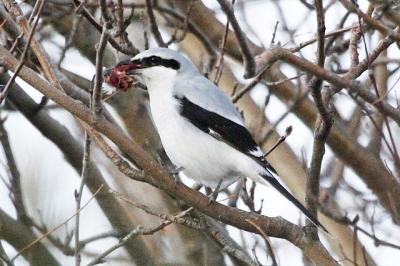Bird of the Month: Northern Shrike
A bird of song and a bird of prey
Take your ordinary backyard bird like a Northern Cardinal, Blue Jay or American Goldfinch and give it a hooked bill that can rip flesh like a raptor and you have a Northern Shrike, sometimes called the "butcher bird" for its feeding behavior.
Winter is the time to find them in our region, having come south from the northern tier of North America where they breed. You should look for a striking gray and white bird offset with a black facemask, wings, and portion of the tail. They are about the size of American Robins and are typically solitary birds. You are most likely to spot them perched up high where they can survey their surroundings for potential prey.
Shrikes belong to the order Passeriformes, which means they are birds that perch, much like the birds mentioned above that many are familiar with. But their hooked beaks lead them to seek out different prey than their fellow Passerines (or songbirds). Rather than eating plants or insects like the others, Northern Shrikes – especially in winter — prey upon vertebrates like small mammals and other birds.
And, like some other raptors they will cache prey on thorns and barbed-wire fences, or wedged into forks of tree branches for later eating. While their cousins may cache food like nuts and seeds, Northern Shrikes cache birds and mammals.
Although finding dead field mice or sparrows speared on a fence may not feel like a "communing with nature" kind of experience, this caching behavior is a natural part of the Northern Shrike's survival strategy and a crafty one at that.
You won't find them in your backyard, though. You'll have to look for them in places with open ground like empty farm fields or pastures that have a few shrubs or trees. Some suburban areas, like the Fairview Business Park near I-90 and Route 98, regularly host these birds, too. It's helpful to look for their larders of stored prey. Even if the bird is not around, the larder is a good sign that a shrike is hunting nearby.
A drive along some country roads this winter may help you find this fascinating but relatively elusive bird. Be sure to admire its cunning.
Mary Birdsong is the lead shorebird monitor for Erie Bird Observatory. Learn more at eriebirdobservatory.org or on their social media channels. She can be reached at mbirdsong@eriereader.com


.png)
